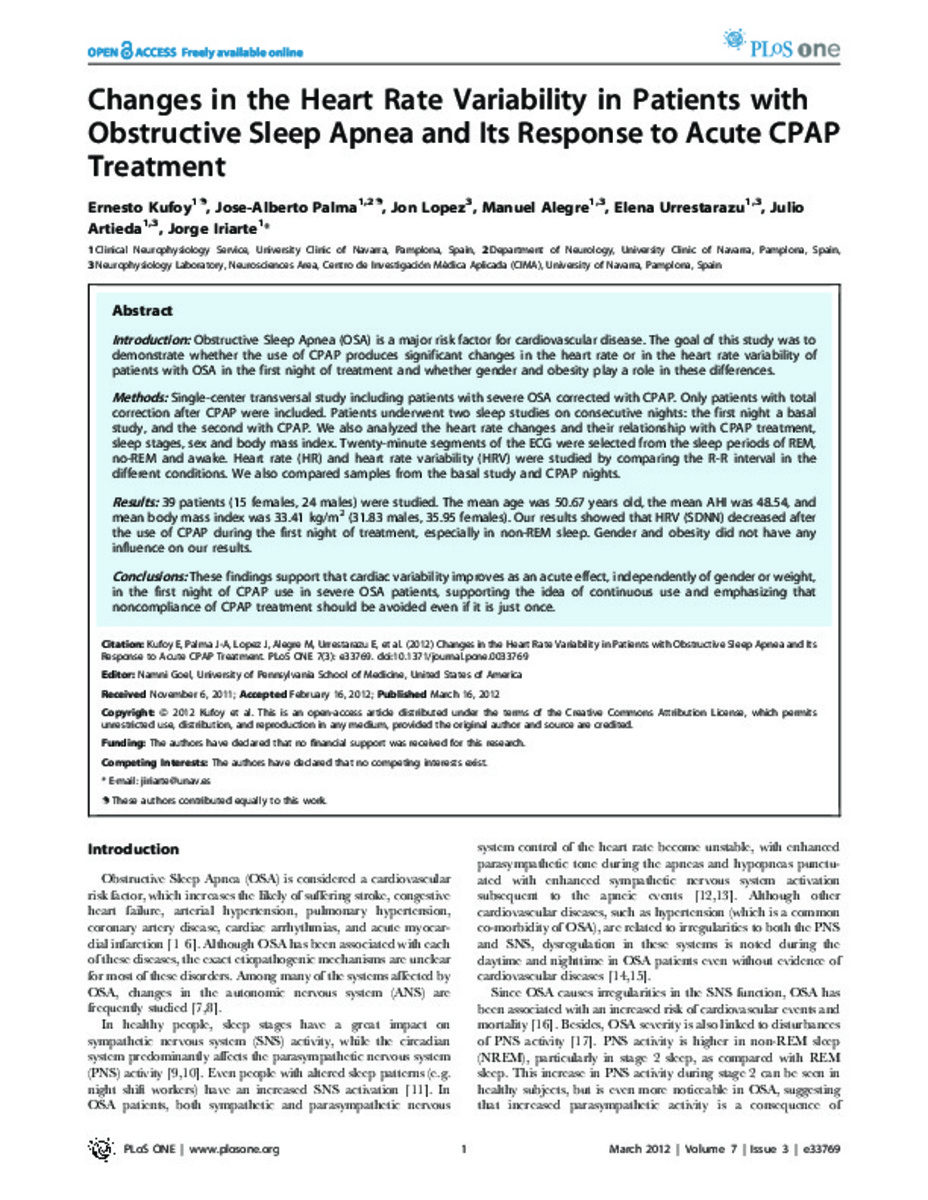Full metadata record
| DC Field | Value | Language |
|---|---|---|
| dc.creator | Kufoy, E. (Ernesto) | - |
| dc.creator | Palma, J.A. (José Alberto) | - |
| dc.creator | Lopez, J. (Jon) | - |
| dc.creator | Alegre-Esteban, M. (Manuel) | - |
| dc.creator | Urrestarazu, E. (Elena) | - |
| dc.creator | Artieda, J. (Julio) | - |
| dc.creator | Iriarte, J. (Jorge) | - |
| dc.date.accessioned | 2012-12-05T13:08:36Z | - |
| dc.date.available | 2012-12-05T13:08:36Z | - |
| dc.date.issued | 2012 | - |
| dc.identifier.citation | Kufoy E, Palma JA, Lopez J, Alegre M, Urrestarazu E, Artieda J, et al. Changes in the heart rate variability in patients with Obstructive Sleep Apnea and its response to acute CPAP treatment. PLoS One 2012;7(3):e33769. | es_ES |
| dc.identifier.issn | 1932-6203 | - |
| dc.identifier.uri | https://hdl.handle.net/10171/27379 | - |
| dc.description.abstract | Obstructive Sleep Apnea (OSA) is a major risk factor for cardiovascular disease. The goal of this study was to demonstrate whether the use of CPAP produces significant changes in the heart rate or in the heart rate variability of patients with OSA in the first night of treatment and whether gender and obesity play a role in these differences. METHODS: Single-center transversal study including patients with severe OSA corrected with CPAP. Only patients with total correction after CPAP were included. Patients underwent two sleep studies on consecutive nights: the first night a basal study, and the second with CPAP. We also analyzed the heart rate changes and their relationship with CPAP treatment, sleep stages, sex and body mass index. Twenty-minute segments of the ECG were selected from the sleep periods of REM, no-REM and awake. Heart rate (HR) and heart rate variability (HRV) were studied by comparing the R-R interval in the different conditions. We also compared samples from the basal study and CPAP nights. RESULTS: 39 patients (15 females, 24 males) were studied. The mean age was 50.67 years old, the mean AHI was 48.54, and mean body mass index was 33.41 kg/m(2) (31.83 males, 35.95 females). Our results showed that HRV (SDNN) decreased after the use of CPAP during the first night of treatment, especially in non-REM sleep. Gender and obesity did not have any influence on our results. CONCLUSIONS: These findings support that cardiac variability improves as an acute effect, independently of gender or weight, in the first night of CPAP use in severe OSA patients, supporting the idea of continuous use and emphasizing that noncompliance of CPAP treatment should be avoided even if it is just once. | es_ES |
| dc.language.iso | eng | es_ES |
| dc.publisher | Public Library of Science | es_ES |
| dc.rights | info:eu-repo/semantics/openAccess | es_ES |
| dc.subject | Obstructive Sleep Apnea | es_ES |
| dc.subject | CPAP | es_ES |
| dc.title | Changes in the heart rate variability in patients with obstructive sleep apnea and its response to acute CPAP treatment | es_ES |
| dc.type | info:eu-repo/semantics/article | es_ES |
| dc.relation.publisherversion | http://www.plosone.org/article/info%3Adoi%2F10.1371%2Fjournal.pone.0033769 | es_ES |
| dc.type.driver | info:eu-repo/semantics/article | es_ES |
Files in This Item:
Statistics and impact
Items in Dadun are protected by copyright, with all rights reserved, unless otherwise indicated.






